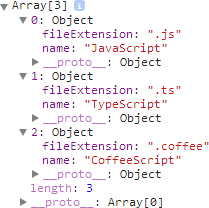Advanced JavaScript Debugging with console.table()
Yesterday, I learned about a nifty little JavaScript debugging feature which is part of Chrome's developer tools. During Web Developer Conference Compact, Marcus Ross (@zahlenhelfer) gave a talk about the various JavaScript debugging tools implemented in Chrome, one of which is the console.table() function I want to show here.
#Logging Array Data with console.log()
Imagine you have created this list of programming languages and their file extensions:
var languages = [
{ name: "JavaScript", fileExtension: ".js" },
{ name: "TypeScript", fileExtension: ".ts" },
{ name: "CoffeeScript", fileExtension: ".coffee" },
];
console.log(languages);The console.log() call will give you the following representation of your data:

That tree view is helpful for debugging purposes, but I find it a little cumbersome to have to open every collapsed object manually. I'm saying we can do a little better with console.table().
#Logging Array Data with console.table()
Instead of calling console.log(), we'll use console.table() now:
console.table(languages);Make sure the console is opened before refreshing the page, otherwise you won't see any output. If you did everything correct, you'll be rewarded with this nice, little table view:

Pretty neat, isn't it? And the best thing is — the columns are sortable:

Of course, tables work best for tabular data. If all the objects have a totally different structure, you'll end up with most of the cells containing undefined values. Still, the property values are neatly arranged and give you a good overview.
#Logging Object Data with console.table()
Another nice thing about console.table() is that it also works with objects:
var languages = {
csharp: { name: "C#", paradigm: "object-oriented" },
fsharp: { name: "F#", paradigm: "functional" },
};
console.table(languages);
'nuff said.
#Filtering the Displayed Object Properties
If you want to restrict the columns to certain properties, you can pass an array of their keys as a second parameter to the console.table() call:
// Multiple property keys
console.table(languages, ["name", "paradigm"]);For a single property, a simple string is sufficient:
// A single property key
console.table(languages, "name");#Bottom Line
I thought I knew about most of the functionality that comes with Chrome's developer tools, but clearly I was wrong. They're crammed with lots of useful functionality just waiting for you to use it. Seriously, go check out the official documentation page; chances are you'll discover some awesome feature you didn't know about.
Also, make sure to check out my other posts about the Chrome Developer Tools:
